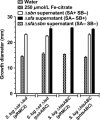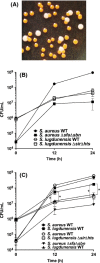Growth promotion of the opportunistic human pathogen, Staphylococcus lugdunensis, by heme, hemoglobin, and coculture with Staphylococcus aureus
- PMID: 24515974
- PMCID: PMC3996567
- DOI: 10.1002/mbo3.162
Growth promotion of the opportunistic human pathogen, Staphylococcus lugdunensis, by heme, hemoglobin, and coculture with Staphylococcus aureus
Abstract
Staphylococcus lugdunensis is both a commensal of humans and an opportunistic pathogen. Little is currently known about the molecular mechanisms underpinning the virulence of this bacterium. Here, we demonstrate that in contrast to S. aureus, S. lugdunensis makes neither staphyloferrin A (SA) nor staphyloferrin B (SB) in response to iron deprivation, owing to the absence of the SB gene cluster, and a large deletion in the SA biosynthetic gene cluster. As a result, the species grows poorly in serum-containing media, and this defect was complemented by introduction of the S. aureus SA gene cluster into S. lugdunensis. S. lugdunensis expresses the HtsABC and SirABC transporters for SA and SB, respectively; the latter gene set is found within the isd (heme acquisition) gene cluster. An isd deletion strain was significantly debilitated for iron acquisition from both heme and hemoglobin, and was also incapable of utilizing ferric-SB as an iron source, while an hts mutant could not grow on ferric-SA as an iron source. In iron-restricted coculture experiments, S. aureus significantly enhanced the growth of S. lugdunensis, in a manner dependent on staphyloferrin production by S. aureus, and the expression of the cognate transporters by S. lugdunensis.
Keywords: Heme; hemoglobin; iron acquisition; staphylococci; staphyloferrins..
© 2014 The Authors. MicrobiologyOpen published by John Wiley & Sons Ltd.
Figures







References
-
- Arias M, Tena D, Apellániz M, Asensio MP, Caballero P, Hernández C. Skin and soft tissue infections caused by Staphylococcus lugdunensis: report of 20 cases. Scand. J. Infect. Dis. 2010;42:879–884. - PubMed
-
- Bae T, Schneewind O. Allelic replacement in Staphylococcus aureus with inducible counter-selection. Plasmid. 2006;55:58–63. - PubMed
-
- Beasley FC, Heinrichs DE. Siderophore-mediated iron acquisition in the staphylococci. J. Inorg. Biochem. 2010;104:282–288. - PubMed
-
- Beasley FC, Vines ED, Grigg JC, Zheng Q, Liu S, Lajoie GA. Centeracterization of staphyloferrin A biosynthetic and transport mutants in Staphylococcus aureus. Mol. Microbiol. 2009;72:947–963. - PubMed
Publication types
MeSH terms
Substances
Grants and funding
LinkOut - more resources
Full Text Sources
Other Literature Sources
Research Materials

